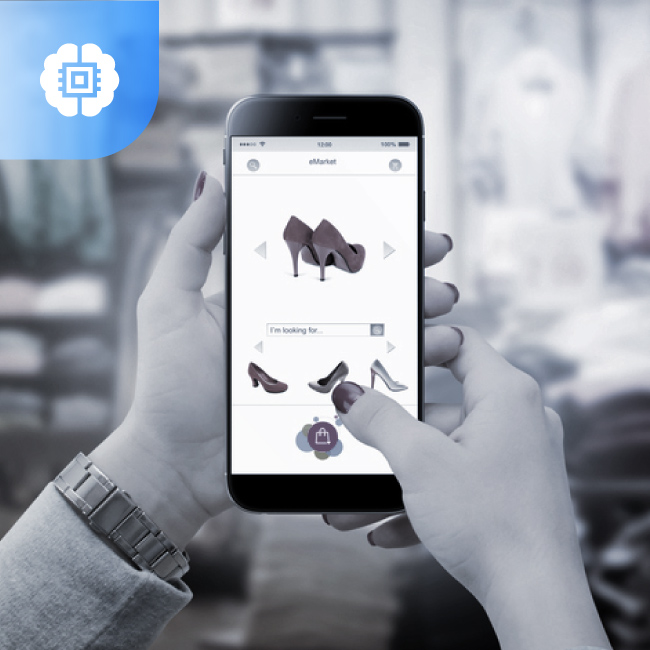
The Future Of Retail Is AI. How?
About this Podcast:
Welcome to The Retail Podcast by Vue.ai: our FIRST ever podcast series on Leaders in Retail. There’s SO much going on in retail right now. Consumption patterns of shoppers are evolving so fast that brands need to be agile to be successful. The retail value chain involves a series of changemakers coming together to enable businesses to sell their products to customers. But who’s responsible for designing these retail experiences? We’re bringing you the answer!!
Episode Transcript:
Akshara Subramanian
Hey, everyone. How's it going? Welcome to The Vue Podcast, our first ever series on leaders and retail. We're so excited to have your listen and I'm your host for today. Just under 12 months ago, we were in the middle of the Great Retail Apocalypse. A disastrous year led to over nine huge retail bankruptcies in twenty seventeen. J.c. Penney, RadioShack and Sears each announced more than a hundred store closures. They were also so many other apparel companies whose stocks hit new multi-year lows, including Urban Outfitters, American Eagle and Ralph Lauren. So what's really going on with retail is Amazon leading retail. Is it because e-commerce has blown up and 60 percent of global e-commerce unicorns from China have consumption patterns of shoppers evolved so much that brands can't keep up? The success of startups like Casper, Bonobos and Warby Parker has really forced physical store retailers to offer similar deals and convenience online brands that have been successful in 2018 know that it's not just about selling products anymore, it's actually about selling personalized experiences and with labels like Stitch Fix raking in millions of dollars using data science and personalization.
Akshara Subramanian
We know one thing for sure the algorithms have arrived, and whether it's a physical store or an online channel, consumers are now placing a lot of value on experiences. The retail value chain involves a series of change makers coming together to enable businesses to sell their products to customers. Each of these actions in the chain really brings a portion of value to the entire process. But who's responsible for designing these retail experiences? We're bringing you the answer. Our podcast features the true champions of retail. We're interviewing CEOs, CEOs, heads of product merchandising, heads of innovation, investors and so many more people who are part of this massive retail value chain. Today, we're in conversation with Ashwani, Ashokan and Julia Dittmar, the founder, CEO and the chief product officer at Buratai. By Matt Strydom Ashwani. There's clearly been a rapid technological evolution in fashion, right? Brands are now so focused on personalizing experiences in a way that they're enabling shoppers to really build products and customize them to the very last detail. What do you think is going on with retail right now?
Ashwini Asokan
I think something really exciting is going on in the retail industry, especially this year, 2018. Just like you said, I think twenty seventeen, it seemed like retail hit a complete rock bottom. But this year, I think this this it got kicked off with the IPO at Stitch Fix just this last quarter. Lululemon's shares just went soaring and they say that, you know, greater than 50 percent of that growth is actually attributed to e-commerce sales, right? There was just a piece last week in the New York Times about how old school retail stores are seeing sales stronger than they've seen in years, right? And I think anytime you go out there in the market, the sentiment for the most part of this year has been absolutely positive. And I think, you know, it's a sign, it's a sign of things to come for retail. And I think the industry definitely hit rock bottom. But it's been interesting to watch. What has happened in 2018 is a lot of these brands and you know, the industry as a whole is starting to figure out how to pick itself up and move on. Right. There's no doubt that I think we just absolutely have to. Give credit where it's due, and Amazon has significantly changed the way consumers shop today than anything we've seen in the recent past, right? And seeing that and then there's social media, which is the second biggest thing I'd say right after Amazon. There's a lot of kudos to Instagram and Snapchat and what these social platforms are doing to how people buy, right? I think both these things have. There's been a significant change in the industry thanks to these two big movements that we've seen or the introduction of technology into this otherwise conservative, slightly more traditional industry.
Akshara Subramanian
Um, you know, Ashwini, it's interesting that you're talking about change in this typically traditional industry, so in terms of the future, what kind of trends are you seeing in retail or things that you actually feel will blow up?
Ashwini Asokan
The first is that retail. It's been very interesting to see how while the retail industry has been a bit traditional, a bit conservative, fashion has always been ahead of the curve. It has always been ahead of the curve when it comes to adopting technology, experimenting right? Whether it's on the runway, off the runway, it's been fascinating to see all the kinds of new technology that they adopt. But what's been missing in this has been experiments that scale, right? The industry has been experimenting for a very long time, right? Whether it's with sustainability or, you know, moving past, you know, issues with body types, you know, culture, race, there's been it's always in the center of conversation on things that are cutting edge from a cultural perspective, from a societal perspective. But if you think about it in the context of technology itself, I think the industry has been experimenting for a very long time with the air. We are, you know, every single new brand. You see new types of experiments in store, but none of these experiments have really scaled. My bet for the next five years is actually on starting to see experiments that scale right.
Ashwini Asokan
And I think that is the first biggest shift that we're going to see in retail is not just embracing things that or technologies that just allow for different types of show and tell and marketing. But embracing technology that allows changing the consumer experience in store, changing the consumer experience online, connecting those experiences across different channels, improving operationally right when you're going up against a mammoth, a giant like Amazon, you really got to the growth is one side of the story. I think the other side of the story is actually competing with the kind of economies of scale that somebody like Amazon has, which means you're really going to think you've got to start thinking about things like operations, right? How do we make supply chain more efficient? How do we make production more efficient? How do you actually begin to use data in a way that your operational efficiency just soars, right? And I think these are all things we're going to start seeing experiments that scale across across different aspects or different parts of the retail value chain.
Akshara Subramanian
Right, that's so true. But where is personalization as a concept feature, when it's across multiple channels?
Ashwini Asokan
You know, I think the last eight to 10 years we saw all things e-commerce saw right? And it was a it was almost like a a swing from all things offline and in-store to the other extreme, which is everything online all the time, right? And what we're beginning to see now is actually a correction of that swing from left to from from one end to the other end right. And we're beginning to see that retailers across the globe are actually thinking about this whole online to offline, offline to online social channels and the role social channels play in this. And I think we've been talking about omnichannel and personalization for as long as we have as an industry, but I think we've been so far away from. Anything omnichannel or anything personalization across channels, and I think that is about to change and you already have, you're beginning to see signs of it, right? You know, order online. I mean, order in store and get it delivered at home or order online and pick it up at a warehouse that's nearby. And there's just so many different types of experiments that companies are doing. But in terms of just bringing that online and offline experience together, right? I think that is going to be a second trend to watch out and something that's going to define who survives successfully, who grows versus the brands that get left out.
Ashwini Asokan
And a part of that story is, of course, social. I don't think you can ignore what the social platforms are going to do in this in this online to offline story. You know, just last week, there was a new piece of research that was published that stated that until recently, all of us kept saying, You know, Google is not where people start their shopping searches. It's all Amazon, right? Amazon had overtaken Google as the platform where consumers did their first searches for products as of last week. That's now changed. It's actually Instagram. Instagram is officially beat Amazon as the platform where consumers are going to start their searches right? And I think that's huge. Think about how in such a short period of time we've gone from Google to Amazon to Instagram, right? And so so I think online, offline social channels, email right. Even some interesting we we've been talking to a bunch of retailers who have been telling us about their experiments with marketing offline as well. Right. So I think we're going to have to start seeing how all of these pieces actually come together over the course of the next five years. And I think that is another space that's going to significantly look different in the next five years.
Akshara Subramanian
Right? Right. And and what would you say AI's role is in the future of retail? In the bigger scheme of things.
Ashwini Asokan
The future of retail is I. I know that comes across a bit biased given we are any company to begin with. But I think, you know, legion of Andreessen Horowitz recently in her Twitter feed was talking about how asking our algorithms the new brand right, which I thought was such a powerful question, right? To say that customer behavior has almost changed completely. It's nothing like it used to be, and the name of the game right now is ease of access is about instant gratification. It's about, you know, Kylie Jenner wear something. And she posted on Instagram. And you know, you can't wait for an entire season before it goes through runway and then gets off into the store for you to wear it right. You just it's it's now a thing, and it's not going to be a thing two weeks from now when when Rihanna picks another designer locally off the streets and, you know, makes them an overnight kind of a sensation, right? So that's how quick things are changing in the industry. And in order to keep up, I think I has a role to play across the board, right? Whether it's giving people just what they want when they want. Just think about the idea of the timeline and what the timeline has done to the way people surf, to the way people look through stuff, right? They expect things to be automatically curated and given to them, and that's where the customer is.
Ashwini Asokan
That is the mindset where the shopper is today. And I think, you know, being able to. No one wants to go to 100 different sites anymore, you know what I mean? I mean, and and so which which begs the question, what is it that's going to be important for all these brands as they move forward, right? And I think the first thing is to get off legacy platforms. We've been seeing brands across the globe work with these mammoth platforms from like twenty years ago, right? And that's not how it's going to be. The companies are going to have to be agile. They're going to have to be really light on their feet. And I think the name of the game is relevance. It's about user intent. And I think finding a way for AI to crack and what does what is it going to take to get a loyal shopper, somebody who believes in your brand for some reason or some value? And I think having the right kind of technology platforms that can cash in on that, that can continue to grow that across the different channels is going to be absolutely key. Right?
Akshara Subramanian
Yeah. I mean, automated processes are definitely a big solution for fashion retailers. Sure. But before we even get to that, what is really the root cause of these problems that need automation in the first place? There's so much talk about the cost of bad data to companies. So what is it about inaccurate data that makes it such a massive problem?
Ashwini Asokan
The underlying building block of all of this, which is just is the data that the retail industry is sitting on even right, and I think that is probably the most important question that having worked with retailers for the last few years continuously, we keep coming back to this problem, right? Saying yes, we can go in and analyze and start looking at all this data to build interesting products, but it's important to acknowledge that the data that's available there is inaccurate, right? Let's just take catalog data as an example. People across the world are sitting and tagging and sitting and manually tagging all this stuff right? And there's extensive inaccuracies in just the way you label the products that you have. And as a result, search becomes an issue. Discovery becomes an issue. And this kind of a bit of a waterfall effect when you have data that is not right or that is flawed. And I think for us is a computer vision company, this has been a big value proposition, just being out there and saying, you know. It's important to get past manual only forms of creating data, so that's that's the first part of this, this data problem. The second part of the data problem is actually how many different types of people or vendors are creating the same data across the different value chain, right? You've got retail workers with so many different types of technological vendors, right technology vendors, merchants, all kinds of partners. That's that in their process. And everybody is creating data, right? So no two departments are looking at the same consumer in the same way.
Ashwini Asokan
Everybody has a very different view of the customer because everybody is producing their own data, right? So, so, so again, how any given department looks at that data is also extremely flawed, right? And especially if we're talking about an online to offline to social channel, if we're talking about this whole omnichannel strategy and personalization, it's important that everybody is getting a singular view of the customer, right, as opposed to how broken it is today. And then the last, but not the least, is actually sharing of that data, right? Since everybody is busy creating their own data, working with their own vendors, having their own perspective on what's going on both in the market as well as with their shoppers. There's a big issue with just them not sharing that data like buying is not looking at marketing data. Marketing is not looking at merchandising data. Merchandising is not looking at the seller data. And you think that, you know, before somebody goes and decides the next season's clothing or before the marketing team puts out a certain set of of of discounts, even or whatever kind of campaigns they have that data instantly accessible to them for decision making at any given point of time, right? So. So I think the the biggest set of problems that I believe that algorithms can solve or I can solve is actually is best framed in the context of a data problem.
Akshara Subramanian
And Julia, what do you think are the biggest inefficiencies in the retail value chain? There's process inefficiencies and overall operational inefficiencies, but is it just that or does it depend on the architecture of the company or the technology they're investing in or not investing in? Can you tell us a little bit about that?
Julia Dietmar
Traditionally, there have been a team that is responsible for a channel, and they're creating their own set of data for distribution to the channel separately, sometimes not even collaborating with their partners in throughout the wholesale department. So what that results in is not necessarily inaccuracies in the data, but a lot of inconsistencies and looking from the other angle. So when the data comes to a retailer from different channels, how could those inconsistencies be solved and taken into example? Something as simple as color? One single color can be described many different ways. It can be orange, or it can be tangerine sunset who searches for what? How do your customers actually look for the products with those types of attributes? So those are the very, very simple issues with data that can be easily solved, especially right now with AI and image recognition technologies. Also going off of the traditional organizational setups because the same chunks of data exist across organizations in different formats, different databases, different systems. However, you want to look at it a lot of times it's very difficult to bring this all together and create that unified view of your product. Unified view of your customer. So that is something that is not very easy to solve. It's it's a it's a it's a problem that is not a very sexy problem. No one really wants to spend time looking at that, but this is something that is absolutely essential for retail to get to that next level.
Akshara Subramanian
And from a retail perspective, what do you think are some of the specific problems that I could solve?
Julia Dietmar
So now with technology that is available, we can solve inefficiencies like labor force. I just think about an example of there is a robotics company called Bossa Nova that developed this amazing robot that walks through the aisles of a grocery store and scans the shelves for restocking. And the signal is immediately sent to the back room. If it's determined that there is no product on the shelf and it's a lot more efficient than deploying an army of workers who are who may or may not know this things. And of course, you cannot sell what you don't have on your shelves. So this is the lost revenue right there and the easily solve problem through technology. Another problem specifically, just kind of closer to what we're doing here with fashion, is being able to do something with technology that you're not even able to do today. Just imagine if you are a brand or retailer that sells clothing in various sizes. And obviously we know and that's been proven through a b tests and all kinds of. Maybe tests, but that showing a piece of clothing on the figure increases your conversion rate significantly. So of course, you know, to do that, you need to photograph everything on on models and that is very expensive. So if you do offer dresses from sizes zero to twenty four at most, you can afford to photograph the smallest regular size and then maybe the smallest plus size. But most customers are somewhere in between not being able to visualize how that garment looks in my size, not necessarily even on me, but on a model of standard size is something that would increase in time to purchase tri fold, and without a technology, it's completely cost prohibitive to even do something like that.
Akshara Subramanian
Julia, can you tell us a little bit about how personalization has evolved as a retail concept?
Julia Dietmar
Being able to take one step further, even with technologies that do exist today, we kind of tend to say, OK, this is working, let's move on to the next thing. And what's what stops happening is we stop optimizing. And even if you look at something as simple as recommendations that are based on the good data, we've gone through kind of traditional statistical models of people looking at this, also looking at that to for furniture and and clothing, something a little bit more efficient as visually similar. So you're looking at the dress, I'm going to show you things that are more similar now. We are actually in the third generation or third iteration of that. What? And that is actually determining customers intent in that particular session and dynamically personalizing for that individual customer, not based on what thousand other shoppers have done. But what this particular customer has done in this session and what she is looking for today. And we have just ran an a test for one of our largest clients, and we have clearly showed that dynamically personalized recommendations increase conversions by more than 100 percent over over visually similar, which is already second generation of of recommendations. So those are kind of the most, I would say, lower hanging fruits that we could have right now that could be easily solved with the AI. And and these types of technologies.
Ashwini Asokan
One thing that's that that came to mind as you were talking about, just we try and do these new experiments and then we're already moving on to the next next thing, right? Like next new technology, let's go. As opposed to really doubling down on a handful of these and making sure that it's and it kind of goes back to the point I was talking about experiments on skill, right? But just think about what what people like Twitter, if you go to Twitter, it's on any given week. It's filled with jokes of people just saying, I bought a vacuum cleaner on Amazon. I'm going to be, you know, completely just just they're going to dump vacuum cleaners on me for the next. I don't know how many weeks, right? And you've got that thing following you everywhere, and it's insane. And I think you know, what you're pointing out is just, it's so incredible how people are like, Oh, personalization is such an old thing or, you know, any of the stuff is all. And no, we are just scratching that surface there because I think being able to double down on what's working and pushing the same thing across channels, right? Imagine if we could take what you're talking about from with the dynamic personalization and everything. And the minute I get off your site, you know what, if my email, you know, is now a continuation of that journey and if I go to social media and it's a continuation of that journey there, right? And I think just suddenly being reminded being it's almost like subtly being very persuasive at that point, right to to across different channels. And I think that's a fabulous point.
Julia Dietmar
There's one more thing that I wanted to bring up, and that is about with your earlier set about omnichannel. Everybody talks about omnichannel, but no one store or no one brand has really solved it. Just imagine like a very, very simple scenario that we face all of us face every day. You go to the clothing store, physical store, you bring a bunch of garments with you in a dressing room, you try them on. Maybe you like one or two and maybe you buy one or two. So the only thing that that brand that store knows about you is what you bought. And even that information is not always translated to other channels, right? But how amazing would it be if the store knew what I tried on and didn't like for whatever reason or maybe like, but found too expensive that they can offer me a promotion or while I'm trying it on in the dressing room, I could get recommendations of how to style it for various occasions right there, somewhere on the screen, in the in the room without even associate being on my back and knocking on my door. So it would be really amazing if this whole experience was brought together. Now, of course, I understand there are again going back to data, going back to processes, online data. Offline data is not always connected in store. Inventory is not always connected to overall inventory. The investments in hardware that needs to be installed in stores is not always justified. But I pretty much guarantee if there is one brand or one retailer that actually did that and prove that there was a real value, then we'll have it come very quickly to all of the stores.
Akshara Subramanian
So there was a recent article on Forbes that talked about investors heavily investing in AI based platforms because they look at it as this profound enabling technology, which is cutting across all sectors, right? And in fact, I ranked higher than SAS marketplaces and even e-commerce as the technology to invest in. Why do you think that is?
Ashwini Asokan
Well, you know, every every type of new technology goes through that cycle, right, or the hype cycle and I think. To be honest, for the longest time, I've been saying, you know, AI is a technology looking for a problem to solve. Right? It's an especially even in the context of computer vision, more so right. And as a company that deals who's who's computer vision is at the core of our business, right? I think we've been asking ourselves this question why? Why computer vision can something else do this better? Like, can can is there an easier way to do something that AI is already doing or is being built to do? And I think that question I I don't think we're at the point as an industry where we can confidently say we know all the answers to what I can do right. And to a large extent, I think the hype cycle typically happens before just before the product goes on or a piece of technology or something begins to scale, right? Because once it skills, it's past that peak, right? And I'd say in so many ways, twenty seventeen eighteen has been like the year of the peak or the year or the peak. Right? And but but that said, I think what is exciting about the technology and the technologies that that comprise AI right is that it's at that inflection point, right people are moving.
Ashwini Asokan
And it kind of goes back to my point about experiments that scale as well. And I think especially in the retail industry, I remember when we started working in twenty fifteen twenty sixteen with retail retailers brands across the globe, everybody was all about image search and visual search, the singular piece like use case that is going to change all things retail, right? And I remember because we had image search was a big piece of the beginning of the day, and one of the things that we started realizing was that no people are actually not taking a picture of what they see out there and, you know, looking for it online as many times during the course of the month, it was not yet there. This was 2015. And as a repeatable behavior, as something that is a habit, it wasn't yet a habit. Instead, people are looking for what Kylie Jenner just wore or posted on her Instagram. So there's a bit of a nuance there in terms of the use case or how people were embracing, you know, the need that they were having and then to look back and go, OK, is integrating image search in the most simplest way, which is like, put a camera in an app, is that the only way to do it? Or are there any other types of use cases that you can basically derive off of that looking at how people are behaving? So I think that is what's beginning to happen right now with the AI, and I think that is the most exciting part of what's going on right? And I think the investor sentiment guess investors across the board and the market has been super excited about AI, but I think, you know, everybody is waiting to see.
Ashwini Asokan
Like that, one or two companies that are really going to take off, right, I think there's a bit of that going on as well where people are waiting to see who is going to be cutting, you know, cutting it and making it there. And I think to that effect, I'd say Stitch Fix has actually done a massive contribution to the industry in that, you know, algorithms driven personal stylist. That's a beginning. And I think that in so many ways is the beginning of the story of AI, that skills. And I think, yes, that hype cycle, the technology is the most kind of promising and the excitement is there. But I think what's coming within the next year or two, to be honest, is probably going to be way more exciting than just the fact that this technology existed until now.
Julia Dietmar
Yeah, absolutely. And to add to that, there is a lot of hype in the AI because there is there are many problems that they can potentially help solve, right? And unfortunately for now, whenever somebody says we are investing in AI. Very often it doesn't it's not very clear what problem they're trying to solve. Investing in the AI in itself without knowing what problem you're trying to solve does not make much sense. I can help with logistics and can help with marketing. It can help with data. I can help with merchandising. There are lots and lots of different problems just within retail, and I'm not even going outside of retail. So obviously there is. There's a lot more in that. But what we're seeing right now is, you know, the the neural networks and deep learning and all of that advances in the technology that have been happening in the last five years. Now we are looking in into generative networks and actually creating something out of nothing, almost right. Creating content. And we here at futurist are solving or at least starting with the problem of solving cost and efficiencies in model photography and not being able to create as much content as is possibly needed for optimized conversion. So that's where we're starting. But this is just the beginning. We're really, really at the very, very, very beginning of this of what this technology can do.
Akshara Subramanian
And from a retail perspective, what do you think are some of the specific problems that I could solve?
Julia Dietmar
We're already seeing emergence of influencers that are not real people, right, should know and little Michela and with we've seen Balmain has done a whole campaign with virtual models. Yes, those models were created by humans, graphic designers and the way they're maintained right now is probably still very cost inefficient. But there is technology that's coming very close on the heels of of that idea that will actually allow for this to be created pretty much out of thin air. So just imagine that those influencers can be every day. There could be a new influencer every day. There could be new influencer for a new audience or new body type or a new new geography, or however you want to imagine this. And and it's not just the imagery, it's it's videos. It's I can even imagine that we could have one day runway shows that were not real. Human models will walk the runway, shows it could be holograms or something of that nature. So, yeah, so this is super exciting. It's super exciting because we are at the beginning and we get to shape how the future will look like. So, yeah, there is definitely a bright future for AI in fashion, at least I had ahead of us.
Akshara Subramanian
I totally agree with you, Julia. There's so much happening in the retail space is so much excitement, you know, and with the proliferation of pop up stores, the phygital phenomenon retail is just exploding. There's so much going on. And before you know it, there's already this big war between Amazon and Walmart getting ready for the next battle. There's jet dot coms, team based shopping experience, this prime wardrobe. And then there's also the chat bots that are changing the way people engage with brands. So no brand can really do away with technology entirely. In fact, there's a report by Forrester called The Future of Jobs and that's forecasted that by twenty twenty two, about seventy six percent of sales tasks like cashier work, restocking shelves and inventory control will be done by robots. And it's not just robotics, right? There's also sure to grab a little Mackellar, there's the newest virtual models of the fashion industry, and they're not even human. So it's really all about leveraging technology and giving consumers this amazing personalized experiences and also giving them something that's really relatable, right? So going back to what Ashley said, algorithms really are the new brand, and it's going to be so many cool, amazing speakers that we have on here that will talk about the future of retail where I stands in this whole scheme of things with retail. So watch this space and don't forget to tune into the next episode of The Vue Podcast Leaders in Retail. Thanks for joining us today, and we really hope you had a good time listening to us. See you soon!
Meet your speakers:

Ashwini Asokan
Founder & CEO, Vue.ai

Julia Dietmar
CPO, Vue.ai

Akshara Subramanian
Director, Customer Marketing, Vue.ai





